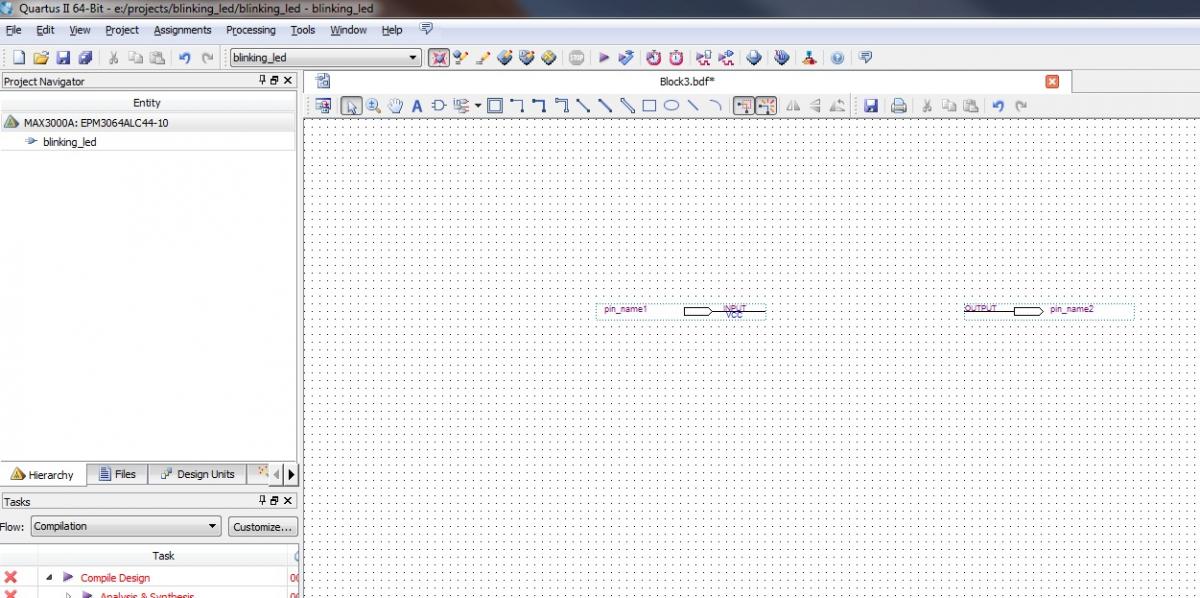
- Breadboard vs altera quartus ii software#
- Breadboard vs altera quartus ii code#
- Breadboard vs altera quartus ii series#
- Breadboard vs altera quartus ii free#
It is hard to tell how much logic will be needed in advance. It all depends on the number of equations needed which in turns depends on how well the values you are looking for can be combined into the least number of logic equations.
Breadboard vs altera quartus ii code#
I think the best approach is to write a piece of code in Verilog or VHDL (*) and then compile it for various CPLDs and if it doesn't fit an FPGA. The limit is the number of logic it needs in between to detect the input values you are looking for. 5v for these larger PLD and FPGAs is rare today. IE, 1/4 of the PLD can be powered to 1.8v IOs while the rest is 3.3v IOs.

You can select different output voltage standards for different banks of IOs, like 3.3v, 2.5v, 1.8v, 1.2v. 77 IOs going the route of additionally piping the video through the PLD, otherwise, you only need 48 IOs. You might consider using the dedicated PLL clk out pin also if you are passing video through the PLD) Total. (Compiles better when using dedicated clocks for clocks and you get the use the PLL if you want. +Use a dedicated clock pin for clk input. Figure 27 bits in for the video, 27 bits out. You also get 10Kx9 onchip dual-port cache memory. Unless it is DRAM, then you need a DRAM controller firmware if you are trying to do a bunch of things on-chip. 101 IOs, Don't need your static ram controller, just wire the PLD directly to the ram and program direct access. Your going for the Altera Max 10 10M02SCE144C8G.
Breadboard vs altera quartus ii series#
13.0 SP1 is the last version to support the popular Cyclone II series of FPGAs.
Breadboard vs altera quartus ii free#
Quartus and ISE both have free versions for personal use, keep in mind that at least with Altera you have to use an older version for some of the older parts that are still popular amongst hobbyists.
Breadboard vs altera quartus ii software#
The choice largely comes down to which software package you like better since you are locked into using the software supplied by the hardware vendor. Again don't spend too much time worrying about which vendor to use, the products are roughly similar, they all use pretty much the same code, it's easy to port from one to the other. Overall I think I like Altera's Quartus II a bit better than Xilinx ISE, and the (clone) programming dongles for the Altera hardware are much smaller and cheaper so that is another perk.

Xilinx and Altera are the two I'm familiar with, I've gone back and forth and have not found a real clear winner, both have quirks and advantages. FPGA development is difficult and has a steep learning curve, that's why so few people do it. I spent probably 2 years tinkering with VHDL before something clicked and I finally got to where I could write the code for a project, fix a handful of typos and other dumb errors and it would compile and more or less work. You have the same learning ability as many of us, it's just a matter of taking the time. Like, change contrast or color, even sharpen/blur/saturation and tint the image if your FPGA has enough gates in it. Piping the entire 24 bit pixel through the FPGA means if there are enough gates, you can manipulate the video picture data, not just decode your 20 outputs. You do not need to do this unless you wish to manipulate the video picture data based on your 20 decoded outputs in perfect synchronicity. I was only suggesting a way to output your white decoding output pin simultaneously with the white pixel data which came into the PLD at the previous clock by piping the 24 bit color data through the PLD as well, delaying it by 1 clock, so you can modify or mask out that white pixel data based on one of your 20 pin decoded outputs. Say if you want to change that white pixel to another color, however, once you decoded your output pin, the next newer pixel is already coming into your PLD, the white pixel has already left.

Once the pixel comes into the PLD and the clock cycles, your output will be set. What I am saying if a you are searching for a white pixel. All the 'if' and 'else' all happen simultaneously. Last paragraph, remember, all you 20 outputs will be computed in 1 clk.


 0 kommentar(er)
0 kommentar(er)
